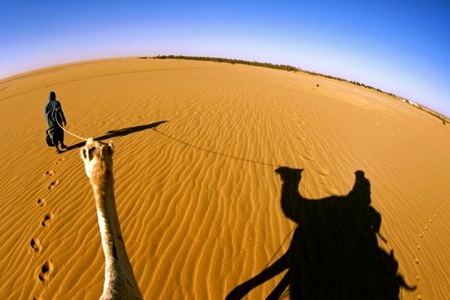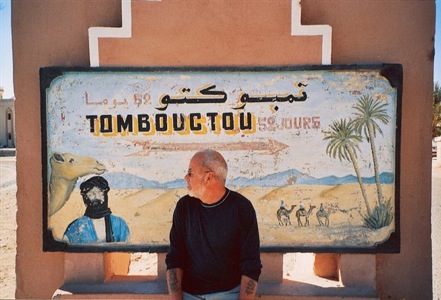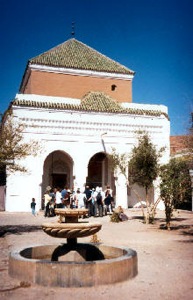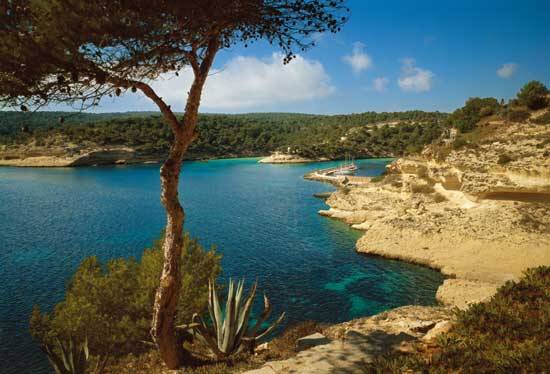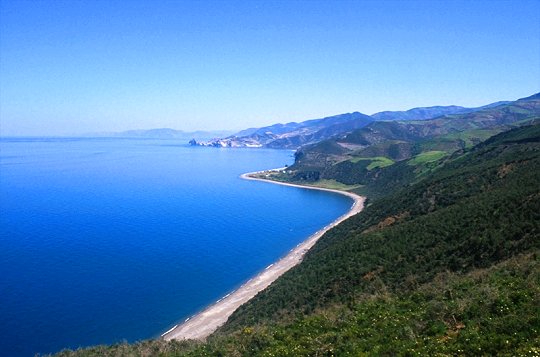Meknes and Fez
Two weekends ago, Our entire program is our first trip Went together to the imperial cities of Meknes and Fez. Fez is the oldest city in Morocco, and was the first capital When the country as we know it today was first, established in the 8th century. We took a bus to Meknes, Which was the capital of Morocco in the 17th century under Moulay Ismail. First stop was the old Stables of Moulay Ismail, and then to the jail Where We Descended into a stark, dark basement holding room Where holes in the ceiling let in light and aussi, in the old days, food Lowered down from above the ground. From there we walked around the medina and into the Museum of Traditional Arts and Crafts of Meknes, a traditional art museum converted from one of the king's riads in the past. Some rooms were preserved as-furnished Originally unbelievably ornate, while in other rooms Where rugs, pottery, and woodwork in the traditional style Meknèsi the floors, walls, columns, ceilings and even tiled Were (zellij) and embellished. After lunch of couscous and juice-any kind or combination of fresh pressed juice you can imagine we continued on our way to Fez. At one spot we stopped on a mountain road to look down into the white-washed city of Moulay Idriss, named Effective the 8th century king of Morocco and off-limits to non-Muslims. Inside the mosque is a city of the same name, Which is a point of pilgrimage for Muslims. It was a spectacular view, nestled into the mountains and looking like a white oasis in the rugged landscape.
Fez at night: fountain and MacDo
Palace at Fez
Faissi soup in the medina
Looking into Karaouine.
Outside one of the doors to the medina in Meknes.
A traditional room maintained in the Riyadh Museum.
Our next stop was Volubilis - called in Arabic Walili, Which is Equally as fun to say - an archaeological site of Roman ruins (and now a UNESCO World Heritage site). Structures like Roman baths Were still intact, as Were some of the elaborate tiling on the floors depicting various scenes and characters. From the top, you can see little towns tucked away into the mountains, and again the vast, dry openness of the landscape.
The center of Volubilis.
On a mountain overlooking the city of Moulay Idriss.
From Volubilis we continued on to Fez, checked into our hotel and proceeded to explore the medina, Which is the Largest and oldest medina in all of Morocco. We Wandered through the labyrinth, passing stalls and stalls of fresh meat, I mean fresh as in animals skinned Displayed everywhere-and then herbs, and then the jewelry / clothes / general artisan products sections. It was like a much, much larger version of the Rabat medina that I'm familiar with, "a medina medina's a" as someone said. The most obvious distinction, aside from the sheer size and crowdedness of the thing, was the behavior of the people working there. The Fez medina is a major tourist attraction, and as a result walking through the medina for us means clustering getting hassled and accosted and pushed to buy things and pay for services. If you stop walking, it's all over. We soon Realized That, and found refuge in a little ice cream parlor, named "Disney Channel", of all things, tucked into one of the alleys.
The lobby inside our hotel in Fez.
The next day we went on year actual guided tour of the medina, with a professor from Al Akhawayn University in Ifrane. First stop was at Madrasa Bou Inania, built in the 14th century as a religious school and mosque. In addition to all the tiling That I pretty much expect to see everywhere by this point, we even ruins, the walls Were All Constructed of wood and stone elaborately carved in Maghrebi Arabic and script. We walked through the "dormitory" area, Which consisted of very small rooms stark, Meant to encourage a life without distraction for the importance of the studies. We left the madrassa and meandered through to the Nejarine Museum, dedicated to historical and regional woodcrafts located in the metalwork section of the enormous medina. After the tour, we found some more sandwiches souk, Which are enough to fill you up for day and year Entire cost Approximately $ 2 American, and then started off on our own tour of the medina to find the famed tanneries.
Center of Madrasa Bou Inania.
Maghrebi script zellij and on the walls of the Madrassa.
The metalwork in the Fez medina area.
Outside the Museum Nejarine in the middle of the medina.
We were Told Were que la tanneries located far in the middle of the medina and That Would Be our best bet to pay someone to take us there, we aim Decided to try to find Them Ourselves. We walked back to the district metalwork (amazingly we remembered how to find our way through the twisting, cramped alleys), Where We Began to be accosted by young boys Asking, "You want to see the tanneries? This way, this way! "Each pointing in a different direction. We finally escaped from one boy who HAD beens Following us through the alleys, only to be taken to the tanneries by his friend-when we got there, we spotted the first boy hiding behind a wall watching us. He was with another boy, all about 12 years old, who Earlier in the day HAD shouted obscenities at us and insults in Arabic (Which We Understood, thanks to our Moroccan friends). Eventually, we got to the roof of a leather goods store Which Looked down over the huge stone-tanning baths filled with different substances for cleaning, Treating, and coloring the freshly skinned leather. Our little guide Explained what was for each Stock substance, there was one area, the little boy Explained to us, Where Were the baths filled with the Technically-named "pigeon shit", to thoroughly clean the leather. We were Shown to a "pharmacy" of pungent herbs and spices Afterwards, to replace the tannery Odors. The owner tried to entice race of us to purchase something, of course, Effective giving us a lengthy explanation of each Stock herb and Their properties. That was the Fez medina, everyone trying to get money from tourists, By Any Means possible, and turning Any would-be stroll into a brisk walk blindered. The shopkeepers get frustrated: We Were walking out of the medina Effective seeing the tanneries and a man was Offering us the menu to his restaurant, so we said "leh, shokran" ("no thank you"), as we always do. We Passed him, and then heard "shokran leh, I HATE LEH Shokran" Oy vey. Sorry, mister, I hate aim "You want to eat here? Good price, 70 dirhams ... "That's life.
Overlooking the dying baths in the tanneries.
The rest of Fez: McDonald's (with elaborately carved ceilings) for dinner on a rainy night, one of the king's Many palaces (one in all of the major cities and regions of Morocco) and a synagogue in the area just outside of the palace Where was the Jewish population Traditionally located. One last tour through the medina for Faissi traditional soup at a soup hole in the wall stand (literally, a hole in the wall), 5 d's for a bowl of hot buttery, garlic bean soup with a hunk of bread. Also a stop outside of the university and Karouine mosque located inside the medina as well, Which was Founded in the mid-9th century, and is still operating today as year academic and religious education center. It was eye-opening to see the dynamics of this city, so old and yet modern in parts, the people so jaded and tough, making a day of exploring a run to preserve your sanity. As with every trip I've been on so far, it's made me look at Rabat in a new light. Spending this weekend I'm not traveling, and I'm Realizing again how nice it is to be ble to walk down familiar streets, seeing the same shopkeepers, going to the coffee Where the owner knows us and will talk to us about Where We 've beens in Morocco or how we find the Arabic language. Such a flap is balanced city, small for a capital city in my opinion and kind of sleepy, Especially When Compared to bustling, high-rise Casa. Goal it's a place where i can carry out my life, not the same as home in America of course, in a way goal that makes sense here.











